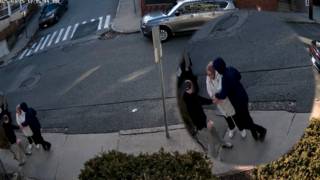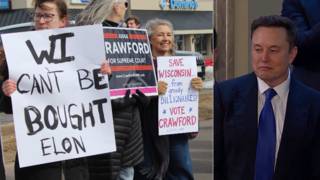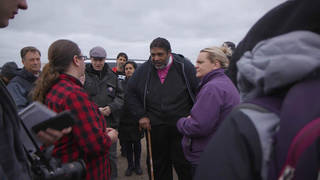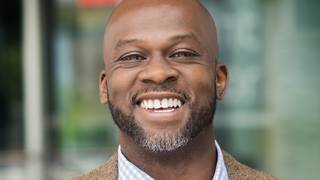
Guests
- Velma Hilllongtime civil and labor rights activist. Fifty years ago, she and her husband, Norman, helped organize the nonviolent protest at the New York World’s Fair that sought to highlight discriminatory hiring practices at the fair and at exhibiting companies. At the time, she was the East Coast field director of the Congress of Racial Equality, or CORE. She went on to work as assistant to the president of the United Federation of Teachers. The couple is working on a memoir about love and activism called Climbing Up the Rough Side of the Mountain.
- Norman Hilllongtime civil and labor rights activist. Fifty years ago, he and his wife, Velma, helped organize the nonviolent protest at the New York World’s Fair that sought to highlight discriminatory hiring practices at the fair and at exhibiting companies. At the time, he was the national program director for the Congress of Racial Equality, or CORE. He went on to work with the AFL-CIO before becoming president of the A. Philip Randolph Institute. He and his wife, Velma, are working on a memoir about love and activism called Climbing Up the Rough Side of the Mountain.
On the 50th anniversary of the 1964 World’s Fair in New York City, which drew 51 million visitors over the span of two years, we look at the untold history of massive protests highlighting racial and economic inequality — and to demand equitable hiring practices at the international event. “We got 700 people from around the country to come in, to sit in at pavilions, to say we want the passage of the civil rights bill, and minorities visibly working at the World’s Fair,” says Velma Hill, longtime civil and labor rights activist. “Because this world is not a white world. It is a white world, and a brown world, and a black world.” She and her husband, Norman, were part of the Congress of Racial Equality, which led the demonstrations. “We thought it important that [they] understand that there could not be a peaceable gathering without economic justice, without equitable representation,” Norman says. He went on to work with the AFL-CIO before becoming president of the A. Philip Randolph Institute. Velma went on to work as assistant to the president of the United Federation of Teachers. They are now writing a memoir about love and activism called “Climbing Up the Rough Side of the Mountain.”
Transcript
AMY GOODMAN: “It’s a Small World After All” by the Disneyland Chorus. Yes, this is Democracy Now!, democracynow.org, The War and Peace Report. A song that many people heard for the same—for the first time at the 1964 World’s Fair. I’m Amy Goodman, with Juan González.
JUAN GONZÁLEZ: Well, events are underway this week in New York to mark the 50th anniversary of that World’s Fair, that, in 1964, when the fair took place in Flushing Meadows-Corona Park, Queens, it drew 51 million visitors over the span of two years. On April 22nd, 1964, President Lyndon Johnson spoke at the fair’s opening ceremonies.
PRESIDENT LYNDON JOHNSON: This fair represents the most promising of our hopes. It gathers together from 80 countries the achievements of industry, the health of nations, the creations of man. This fair shows us what man at his most creative and constructive is capable of doing.
JUAN GONZÁLEZ: Yes, it was 50 years ago that fair-goers flocked to the World’s Fair to get a taste of the wider world and a glimpse of a possible future full of rocketships, superhighways and complex kitchen gadgets. But that year, a very different future was being chiseled out by a devoted group of civil rights activists who used the prominence of the World’s Fair to propel their fight for racial equality into the national consciousness. Their vision for the future involved less spaceships and more integrated schools. They were less interested in the fair’s futuristic exhibits and more concerned with equitable hiring practices on the fair’s grounds. The protesters greeted President Johnson with chants for the passage of the Civil Rights Act. Of the 700 who demonstrated, nearly 300 were arrested and carted off to jail.
AMY GOODMAN: We turn now to looking at this largely untold history. We’re joined by Norman and Velma Hill, longtime civil and labor rights activists. Fifty years ago, they helped organize that nonviolent protest at the New York World’s Fair.
We welcome you both to Democracy Now! Talk about what the scene was like. You got into the World’s Fair, or you were standing right outside?
VELMA HILL: We got into the World’s Fair. But first let me just thank you for having us here. We’re very happy to be here, and we’re very happy to talk about an event that most people just aren’t aware of now. It was April 22nd, which, by the way, was Norm’s birthday. So we were doing—
AMY GOODMAN: Happy birthday, Norman.
NORMAN HILL: Thank you.
VELMA HILL: We were doing what we did most of the time, which was demonstrating. Now, that was a CORE demonstration. But—
AMY GOODMAN: You mean the Congress of Racial Equality.
VELMA HILL: The Congress of Racial Equality, CORE, under Jim Farmer, because CORE became a very different organization years later. But this was under Jim Farmer right after the Freedom Rides in the South. And we were very concerned. Norm was the program director of CORE, and we were doing many things to bring the—what was going on in the South to the North, because there were always problems in the North.
NORMAN HILL: Yeah, and Velma was East Coast field secretary.
VELMA HILL: Of CORE, yes. We were a couple at CORE. And we had something very interesting happening on that April 22nd. We had what we called extremist groups in CORE who had decided that they agreed with our goals, but they didn’t like our tactics. What they wanted to do was what they called a stall-in. And a stall-in, they had planned to do some very interesting things. They had planned to go onto subways, stop subways from running by pulling—pulling down the—
NORMAN HILL: Emergency.
AMY GOODMAN: The emergency brake?
NORMAN HILL: Yeah, the cord.
VELMA HILL: The emergency brake. They had planned to sit in at the bridges and stop people from going to work. And they had planned to take ravenous rats and to set them loose when President Johnson was going to speak. And we just didn’t think that that was a good idea. We thought that that’s really preventing workers from going to work, who had nothing to do with the World’s Fair. So we planned something at the World’s Fair where we got 700 people from around the country to come in to sit in at pavilions, to say we want the passage of the civil rights bill, and we want to make sure that there are minorities working at the World’s Fair, visibly working, because this world is not a white world. It is a white world and a brown world and a black world. And we wanted to make that statement and make it clear.
JUAN GONZÁLEZ: And, Norman Hill, what about the hiring of people in the weeks and months before that at the World’s Fair? Had there been clear problems in the hiring at that point?
NORMAN HILL: Yes, there were. It was clear to us that the workforce was not representative and did not include minorities, especially blacks, at all levels. And so, we felt it was important to dramatize this situation and confront the key decision-makers at the World’s Fair about this problem and to organize a demonstration that would directly confront the World’s Fair and those who were running it. And we did so by assembling a group of demonstrators, as Velma indicated, who sat in at various pavilions of the World’s Fair, including the main entrance, where James Farmer, the national director of the Congress of Racial Equality; Michael Harrington, Democratic Socialist writer and author or The Other America, exposé of poverty in America; Bayard Rustin, A. Philip Randolph’s most outstanding colleague and a master strategist and tactician of the civil rights movement; Ernie Green, assistant secretary of labor under Ray Marshall and President Clinton; and—
VELMA HILL: And before that, one of the Little Rock Nine, yes.
NORMAN HILL: In Little Rock, Arkansas.
VELMA HILL: Yes.
NORMAN HILL: Who endured mob threats, and Eisenhower had to call in the troops to enable them to integrate Central High School in Little Rock in 1957. But we think that the clear focal point in 1964 here in New York City was the World’s Fair and our attempt to demonstrate that the workforce was not representative and inclusive.
VELMA HILL: By the way, one of the things that happened at that World’s Fair demonstration, I think it was the first time that we actually used walkie-talkies. You know, CORE sort of came into the 20th century with walkie-talkies. They were very big, nothing like you would see now. And we had about 15 CORE staffers who were placed all around the World’s Fair. And Norm was called King Cobra. And here’s Norm, who isn’t imperial at all. But he was King Cobra, and I was Cobra One. And we took them out a week before and practiced what they would say, who got arrested, which pavilion it was, and we had a whole dialogue so that we would know what was going on at the World’s Fair.
JUAN GONZÁLEZ: Well, I want to turn to a clip from the person who was in charge of the World’s Fair, perhaps one of the—the most influential figure in the history of modern New York, Robert Moses.
VELMA HILL: Yes.
JUAN GONZÁLEZ: He’s been memorialized, of course, in Robert Caro’s book, The Power Broker—
VELMA HILL: Yes.
JUAN GONZÁLEZ: —about the master builder of urban America. And he spoke at the opening of the fair in April of 1964.
ROBERT MOSES: We invite visitors from every state and land, solicit their friendship, and devoutly hope that in presenting here this Olympics of progress, we shall draw them closer together in our shrinking globe and thus, in the end, promote peace.
JUAN GONZÁLEZ: That was Robert Moses. And as Robert Caro has pointed out in his book, Moses and all of his building and reconfiguring of New York really destroyed many black and Hispanic communities. He had a racial edge to much of his redevelopment approach, and racial bias. And I’m wondering, your recollections of Moses at that time and his importance in the city?
NORMAN HILL: Well, he attempted to be an imperial figure and, in fact, a kind of a law unto himself. And he was, to put it gently, insensitive to the needs and concerns of minorities, especially blacks, in that period. And we thought it important that he understand that this could not be a peaceable gathering without economic justice, without equitable representation at all levels of the World’s Fair workforce.
AMY GOODMAN: I wanted to turn to LBJ. After years of setbacks, advocates for equality, you—one of the protest’s reasons was—at the World’s Fair, was the the signing of the Civil Rights Act. This was Johnson just a few months later signing the Civil Rights Act.
PRESIDENT LYNDON JOHNSON: We must not approach the observance and enforcement of this law in a vengeful spirit. Its purpose is not to punish. Its purpose is not to divide, but to end divisions, divisions which have lasted all too long. Its purpose is national, not regional. This Civil Rights Act is a challenge to all of us to go to work in our communities and our states, in our homes and in our hearts, to eliminate the last vestiges of injustice in our beloved country.
AMY GOODMAN: Now, that was July 2nd, 1964. You protested the World’s Fair April 22nd, 1964, pushing for this, as well as fair hiring. And just before this, in the summer before, Dr. Martin Luther King, Bayard Rustin, 250,000 other people—
VELMA HILL: Absolutely.
AMY GOODMAN: —were on the Mall in Washington, D.C. I wanted to turn to Bayard Rustin speaking in 1963 on August 28th.
BAYARD RUSTIN: We demand that segregation be ended in every school district in the year 1963! We demand that we have effective civil rights legislation—no compromise, no filibuster—and that it include public accommodations, decent housing, integrated education, FEPC and the right to vote. What do you say? We demand the withholding of federal funds from all programs in which discrimination exists. What do you say?
AMY GOODMAN: That was Bayard Rustin, the chief organizer, along with A. Philip Randolph, of the 1963 March on Washington. Norm Hill, you became head of the A. Philip Randolph Institute, so you worked with both of these men through this period.
NORMAN HILL: In fact, I was staff coordinator under A. Philip Randolph and Bayard Rustin of the March on Washington.
AMY GOODMAN: Your thoughts today, 50 years later?
VELMA HILL: I think it’s very interesting, because that March on Washington did something that most people don’t understand. Before the March on Washington, the question of race was the dominant factor that we were protesting about. With the March on Washington and those demands, there was a convergence of race and class that most people don’t understand. But look at what Bayard was saying, what we wanted. We wanted full employment. The civil rights movement—
AMY GOODMAN: We have 10 seconds.
VELMA HILL: Ah, we wanted full employment and things that were both—were economic in nature.
AMY GOODMAN: And I think what’s so fascinating is that when the Civil Rights Act was signed, now the emphasis on LBJ, it was about movements—
VELMA HILL: Yes.
AMY GOODMAN: —leading into that moment.
VELMA HILL: Yes.
AMY GOODMAN: And you were a part of that movement, leading 700 people protesting in the World’s Fair a few months before.
VELMA HILL: Absolutely.
AMY GOODMAN: Norman and Velma Hill, I want to thank you so much for being with us to remind us of this historical moment, or teach us about a moment we didn’t even know about.
That does it for the broadcast. I’ll be speaking at the Green Fest at 54th Street, Pier 94, in New York Saturday at 3:00.












Media Options